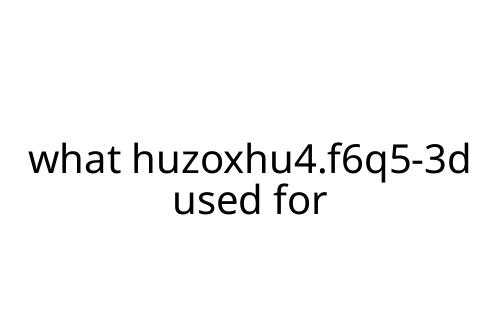what huzoxhu4.f6q5-3d used for
When you come across a term like "huzoxhu4.f6q5-3d," it can look like a random string of letters and numbers. But in technical fields, such designations often serve a real purpose. Let’s break down what huzoxhu4.f6q5-3d is used for, what you need to know, and why it might matter to you.
Possible Contexts and Use Cases
The first step is pinning down what huzoxhu4.f6q5-3d actually refers to. In most instances, identifiers with patterns like this are used for software keys, configuration codes, file names, or device serial numbers. Sometimes, they’re placeholder names in tech guides or documentation. If you found huzoxhu4.f6q5-3d in a manual, online forum, or system log, consider what you were looking at—this context will help clarify its function.
1. Product Activation or Licensing
One common use for alphanumeric strings is software verification. Companies issue codes like huzoxhu4.f6q5-3d to authenticate software, unlock specific features, or manage subscriptions. If you’re installing an application and are prompted for such a code, it’s essential for activation. The benefit here is secure access and protection against unauthorized use. However, losing or sharing it can risk unauthorized use or deactivation.
2. Device Identification
Manufacturers often assign unique IDs to hardware. This helps with warranty claims, repair tracking, and support requests. If huzoxhu4.f6q5-3d appears on a hardware label, it’s likely a device serial or model number. This makes it easier to locate support articles, check compatibility, or register the product. The downside is, not knowing how to read or where to input this ID can be confusing.
3. Configuration and Networking
In IT and networking, codes like huzoxhu4.f6q5-3d may be used as identifiers for network devices, configuration profiles, or encrypted keys. For example, in a mesh network, each node might have a unique ID for security and maintenance purposes. This keeps networks organized and secure but demands careful record-keeping.
4. Sample or Placeholder Code
Technical documentation sometimes uses strings like huzoxhu4.f6q5-3d as placeholders. These mark where users should input their own values. If that’s what you’re seeing, make sure to replace it with your actual code or information—failure to do so can result in errors or misconfiguration.
Practical Tips
- Double-check the source: Is huzoxhu4.f6q5-3d a real, unique code for your product, or just an example?
- Keep it secure: If it’s a license or device ID, avoid sharing it publicly.
- Look for context clues: Manuals, support sites, and forums often explain what the code is for.
Conclusion
So, what is huzoxhu4.f6q5-3d used for? Most often, it serves as a unique identifier—whether for product licensing, hardware tracking, network configuration, or as an example in documentation. Identifying the context is key. When in doubt, check the instructions or seek support from the provider tied to the code. The goal is always secure, accurate, and efficient operation—no matter how odd the code might look.


 Fredey Gatestandser, the founder of Drip Travels Hide, is a seasoned traveler with a passion for exploring unique destinations. He created the platform to go beyond typical tourist spots, offering expert tips and hidden gems for unforgettable journeys. Through his vision, Drip Travels Hide helps adventurers discover new places with ease and inspiration.
Fredey Gatestandser, the founder of Drip Travels Hide, is a seasoned traveler with a passion for exploring unique destinations. He created the platform to go beyond typical tourist spots, offering expert tips and hidden gems for unforgettable journeys. Through his vision, Drip Travels Hide helps adventurers discover new places with ease and inspiration.